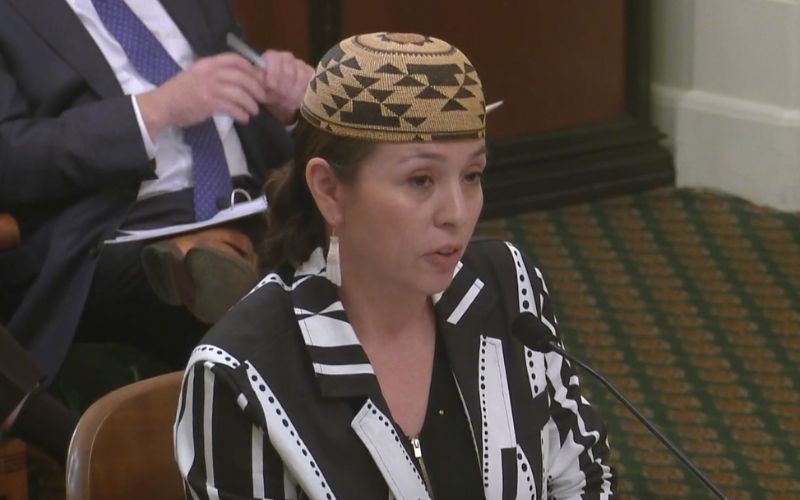
- Details
- By Elyse Wild
When Yurok citizen Taralyn Ipina's sister went missing in the San Francisco area last year, her hope rested on the state’s newly implemented Feather Alert system. Launched Jan. 1, 2023, the statewide alert system for missing Indigenous people held the promise of aiding in search and recovery efforts.
After six days with no word nor sighting of her sister, Ipina's request for the Feather Alert was rejected. Local law enforcement officials, who review the alert requests before sending them to the California Highway Patrol, ruled that Ipina’s request didn’t meet the system’s criteria.
At that point, Julia Oliveria, the Yurok tribe’s Missing and Murdered Indigenous Peoples (MMIP) investigator, intervened in an attempt to get the Feather Alert request approved. Her request was also denied.
"It left my family feeling hopeless and devastated," Ipina said.
Her sister was eventually found alive, but the experience of being rejected for trying to use a system designed to help made a hard situation even worse.
Ipina testified before California's Assembly Select Committee on Native American Affairs on Wednesday at an informational hearing at the state capitol building in Sacramento on the effectiveness of the Feather Alert.
"She was gone for far (longer) than needed to be, and we all experienced trauma as a result," Ipina told committee members. "I want you to ask yourself what would you do if this was your sister, your grandmother, your daughter? What lengths would you go to ensure their safety?"
The MMIP crisis is prevalent across the United States, with Indigenous peoples being murdered at a rate ten times the national average. Native American women comprise 2% of the total population of women in the United States. Homicide is one of the leading causes of death for Native women ages 10-24 and the fifth leading cause of death for Native women 25-34. While the Bureau of Indian Affairs estimates there are 4,200 unsolved MMIP cases, the actual number is likely higher as there is no accurate count of how many Indigenous people go missing or are murdered annually.
Advocates say the crisis is driven by jurisdictional confusion, systemic racism and apathy. California, which is home to 1.14 million Native Americans, ranks fifth in the number of MMIPs in the nation.
Wednesday's hearing was led by Committee Chair Assemblymember James C. Ramos (Serrano/Cahuilla Tribe), author of the Feather Alert legislation, which is the state's first legislative measure to combat the Missing and Murdered Indigenous Peoples Crisis. Ramos opened the hearing with a Big Horn Ram song, a traditional Serrano song.
As the committee’s members moved in and out of the hearing due to scheduling conflicts, Ramos stayed for all of the testimony from tribal leaders and advocates, affected community members,and tribal, county, city and state law enforcement.
Merri Lopez-Kiefer, director of the California Attorney General’s Office of Native American Affairs, testified to the state's actions on the MMIP crisis as mandated by AB3099, also authored by Ramos. That bill requires the state to identify challenges in reporting and identification of MMIP. The attorney general's office is required to submit a report on its findings to the state legislature in 2025.
According to Lopez-Kiefer, those actions include: Engaging with tribal governments, community members, survivors, law enforcement, and state and federal justice partners; supporting the implementation of Savannah's Act; launching two comprehensive tribal community surveys; hosting two MMIP events for survivors and families to submit DNA and engage with law enforcement.
"Throughout all the efforts I shared about today, there have been successes and challenges to fulfilling the duties we've been entrusted to carry out," Lopez-Kiefer said, noting the primary challenge to solving MMIP cases as inaccurate data. Current limitations and inconsistent data and reporting protocols have thus far inhibited meaningful progress, she said.
Rejected requests
A considerable portion of Wednesday's hearing examined the chain of command processes and rejected Feather Alerts like the one Taralyn Ipina experienced. Feather Alert requests are first made to local law enforcement, which assesses the request for the following five criteria:
- The missing person is an indigenous woman or indigenous person.
- The investigating law enforcement agency has utilized available local and tribal resources.
- The law enforcement agency determines that the person has gone missing under unexplainable or suspicious circumstances.
- The law enforcement agency believes that the person is in danger.
- There is information available that, if disseminated to the public, could assist in the safe recovery of the missing person.
Requests must meet all five criteria for an alert to be issued. After the request has been assessed, local law enforcement either approves the request and moves it up to the California Highway Patrol — or denies it.
Lack of trust, resources, and communication between tribal communities and local enforcement entities were noted by tribal leaders at the hearing as barriers to the current system's being as effective as it could be.
Josefina Frank, tribal chairwoman of the Bear River Band of the Rohnerville Rancheria, testified that when she first read the criteria for a Feather Alert, her heart sank. In particular, the criteria that the investigating agency utilized available local and tribal resources was a roadblock for many tribal members.
“When I read that, I see that as being the stop for tribal members because those relationships have not been built with local law enforcement outside of our tribal police," Frank said.
Ipina's Feather Alert request was one of five made last year, three of which were rejected and two of which were issued. One of the rejected alerts was for a 14-year-old girl from the Pechanga Band of Indians who had a history of mental health and substance abuse issues. The girl was recovered alive after the tribe issued an alert through their own social media.
"I know this child closely. We had a lot as much information. We really felt like we had met all the criteria," Pechanga Band Councilmember Catalina Chacon told the committee. "It was very disheartening when we were declined … I'm happy to say that the child is safe now. "
There was consensus among those who testified that the Feather Alert ought to be amended to allow tribes to submit requests directly to the California Highway Patrol. That would help circumvent the numerous issues with having local law enforcement middlemen.
Morning Star Gali, a member of the Ajumawi band of the Pit River Tribe, testified about her own experience seeing the suspicious deaths of family members go uninvestigated. "If a [missing person] is meeting criteria on behalf of the tribe, that should absolutely be considered by law enforcement," she said.
More Stories Like This
Native News Weekly (August 25, 2024): D.C. BriefsUS Presidents in Their Own Words Concerning American Indians
NDAA passes House; Lumbee Fairness Act Advances
NFL, Vikings to Host Native All-American Game, Youth Flag Clinic
Senate Committee on Indian Affairs Passes 12 Bills to Strengthen Tribal Communities
Help us defend tribal sovereignty.
At Native News Online, our mission is rooted in telling the stories that strengthen sovereignty and uplift Indigenous voices — not just at year’s end, but every single day.
Because of your generosity last year, we were able to keep our reporters on the ground in tribal communities, at national gatherings and in the halls of Congress — covering the issues that matter most to Indian Country: sovereignty, culture, education, health and economic opportunity.
That support sustained us through a tough year in 2025. Now, as we look to the year ahead, we need your help right now to ensure warrior journalism remains strong — reporting that defends tribal sovereignty, amplifies Native truth, and holds power accountable.
 The stakes couldn't be higher. Your support keeps Native voices heard, Native stories told and Native sovereignty defended.
The stakes couldn't be higher. Your support keeps Native voices heard, Native stories told and Native sovereignty defended.
Stand with Warrior Journalism today.
Levi Rickert (Potawatomi), Editor & Publisher


